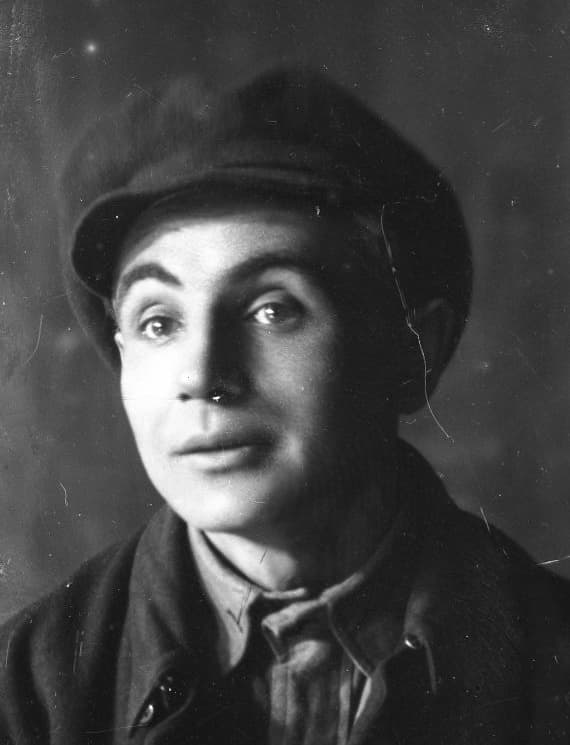Friedrich Schiller’s tragedy in 4 acts
Premiere: November 11, 1928
Director: Yanuarii Bortnyk
Creative Editor: Les Kurbas
Stage Design and Costumes: Nisson Shyfrin
Composer and Conductor: Bohdan Kryzhanivskyi
Cast
Gianettino Doria – Mytrofan Kononenko, Domian Kozachkovskyi
Fiesco – Les Serdiuk, Oleksandr Dolinin
Verrina, Republican Conspirator – Danylo Antonovych, Ivan Marianenko
Bourgognino, Republican Conspirator – Vasyl Stetsenko, Ivan Havryshko
Calcagno, Republican Conspirator – Serhii Khodkevych
Sacco, Republican Conspirator – Mykhailo Zhadanivskyi
Lomellino – Republican Conspirator – Mykola Savchenko
Zenturione, Courtier – Oleksandr Khvylia
Zibo, Courtier – Oleksandr Romanenko
Asserato, Courtier – Borys Drobynskyi
Romano, Painter – Demyd Babenko
A Moor – Yosyp Hirniak
A German – Hryhorii Kozachenko
Seditionists – Hladkov, Pavlo Umanets, Andrii Shutenko
Leonora – Olimpiia Dobrovolska
Arabella – Sofiia Fedortseva
Rosa – N. Horna
Julia, Gianettino’s Sister – Nataliia Uzhvii
Berta, Verrina’s Daughter – Lesia Datsenko
Romans – Tamara Zhevchenko, Serhii Karpenko
Ladies at Masquerade Ball – Pihulovych, Yaroslava Kosakivna, Antonina Smereka, Lidiia Krynytska, Iryna
Steshenko, Yevheniia Petrova, Yuliia Fomina, Klavdiia Pilinska
Courtiers, Genoans, Soldiers, Citizens – I. Bilashenko, P. Bilokin, Serhii Karpenko, Andrii Makarenko, Mykola
Nazarchuk, Nikitin, Pavlo Umanets, Roman Cherkashyn, Andrii Shutenko
The plot of Schiller’s tragedy, which takes place in 1547, involves a string of crimes orchestrated by the young intriguer Fiesco. The creators of the show cut it down, leaving sublimated sharp plot twists that sped up the action and pointed to the fatally inevitable pulsation of political intrigue. In Berezil’s version Fiesco wants to seize power and conspire to kill the tyrannical Duke Gianettino Doria, nephew of the doge of Genoa. His intensions, shrouded in the romantic impulse to liberate the Genoese from tyranny, are in fact driven by personal ambitions and egocentrism. Fiesco’s insidious plans don’t pan out: he accidentally kills his beloved wife Leonora and dies at the hands of the republican conspirator Verrina.
Berezil’s performance was built on historical and modern parallels – modern heroes acted in circumstances of the past. It provoked many comparisons and allusions among the audience and leading critics. V. Morskyi, M. Romanovskyi, Yu. Smolych and others wrote reviews for periodicals. M. Romanovskyi noted: “The images of the performers are both historical and modern. The costumes are deliberately modern. The whole show has one common note – the note of tragic vanity.” [2] Nisson Shyfrin’s stylized monumental scenery created the atmosphere of the Renaissance, openly accentuated with exquisite costumes of fine tulle through which the everyday clothes of Soviet citizens shone through.
Obviously, for Ukraine at the time the theme of tyranny was both relevant and dangerous: too many parallels could be drawn between events on stage and in real life. At the same time, the historical atmosphere probably saved the play from censorship, shifting the emphasis to the perfection and diversity of the acting.
Most of the onstage images created by the Berezil actors with the help of hyperbolism, psychological immersion and emotion expression were ambivalent – their perception and assessments weren’t unequivocal. Each of them accumulated beauty and ugliness, greatness and vileness, heroism and vanity.
The most striking contrast of behavior and character traits was embodied by lead actor Les Serdiuk. His hero is indomitable and romantic, but also pragmatic and cruel. His counterpart – republican Verrina played by Dmytro Antonovych – was a noble idealist who was devoted to his people. Yosyp Hirniak also go complimentary reviews from critics for his role as the Moor. According to V. Morskyi, “the talented actor was able to present that romantic rascal in such a modern way that his character became one of the central heroes of the play.”
According to researcher N. Chechel, who made a fragmentary reconstruction of the play, an interesting directorial discovery was the living picture, where “a black giant stabs a young white woman. The expressive movement of the half-naked bodies is emphasized. The barbarian tyrant shocks the republic.” [4, 102]. This picture, full of play of light and shadow, inspired the rebels to revolt and modeled the end of the tragedy, where Fiesco kills Leonora.
The combination of historical material and turbulent realities of the present in Yanuarii Bortnyk and Les Kurbas’s Fiesco’s Conspiracy at Genoa created a topical play about eternal human values (love and dignity) and, at the same time, according to critic B. Simantsev became a bridge “that united classical and revolutionary art.”

